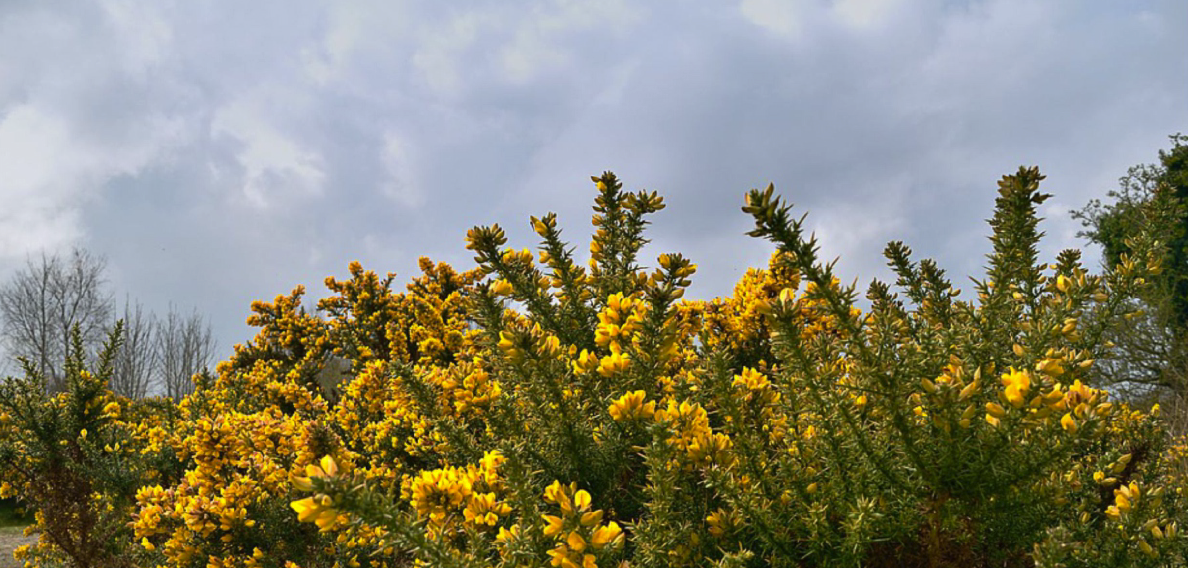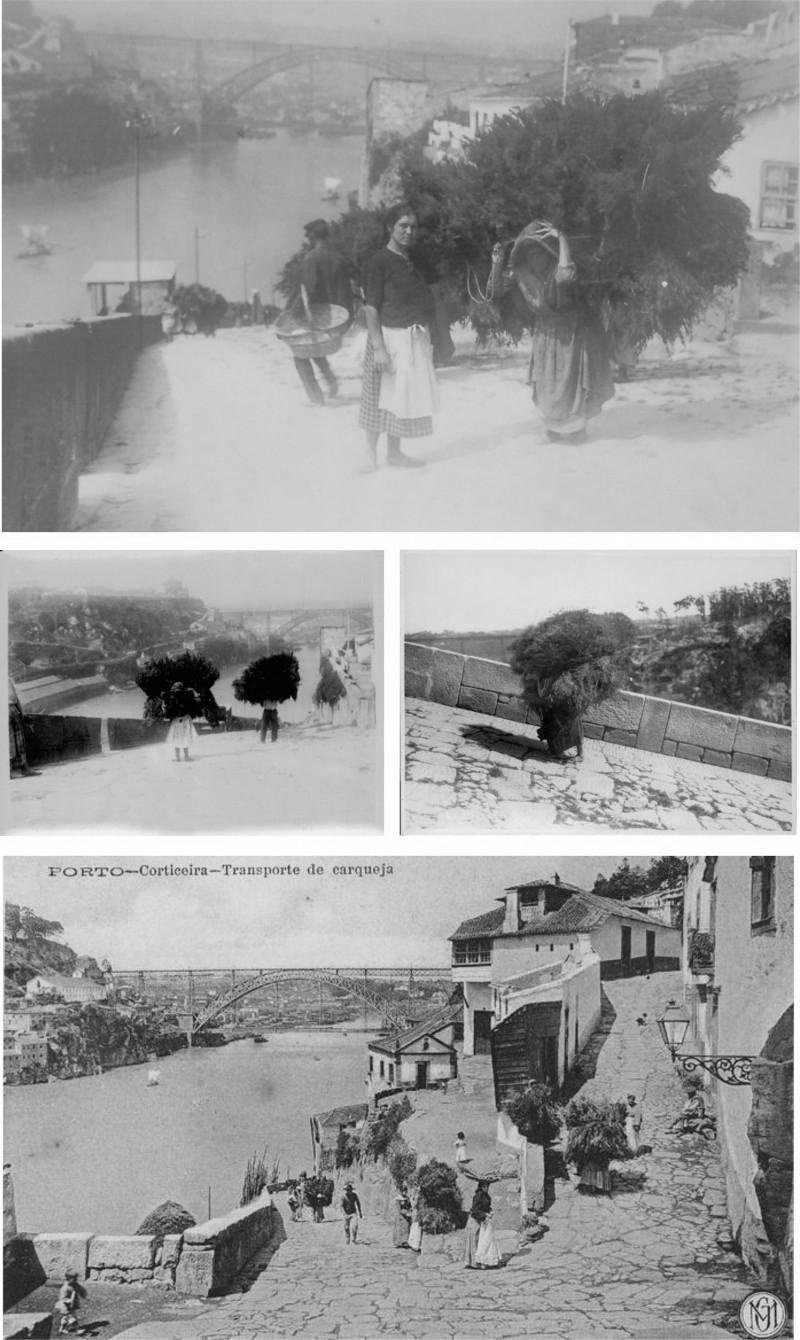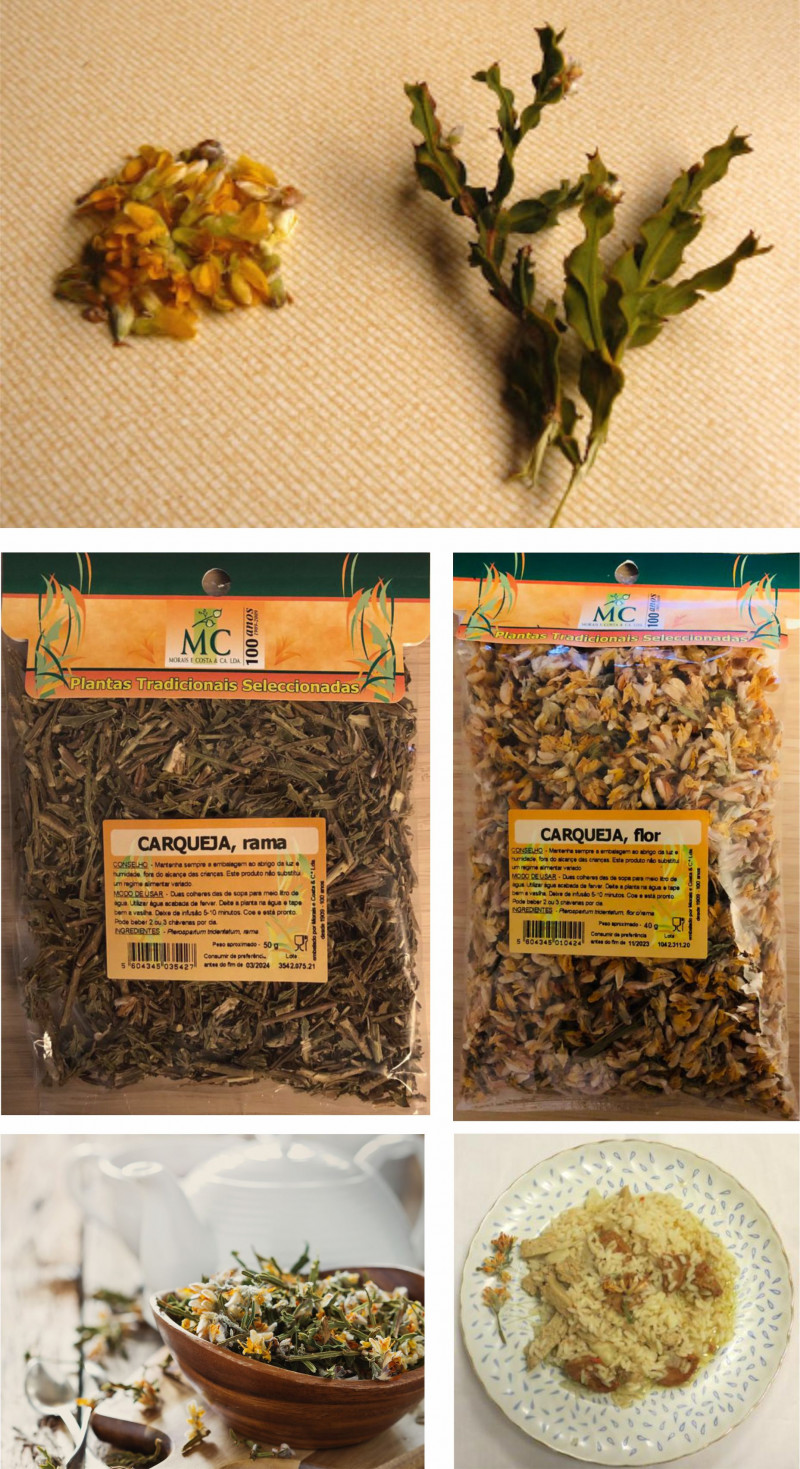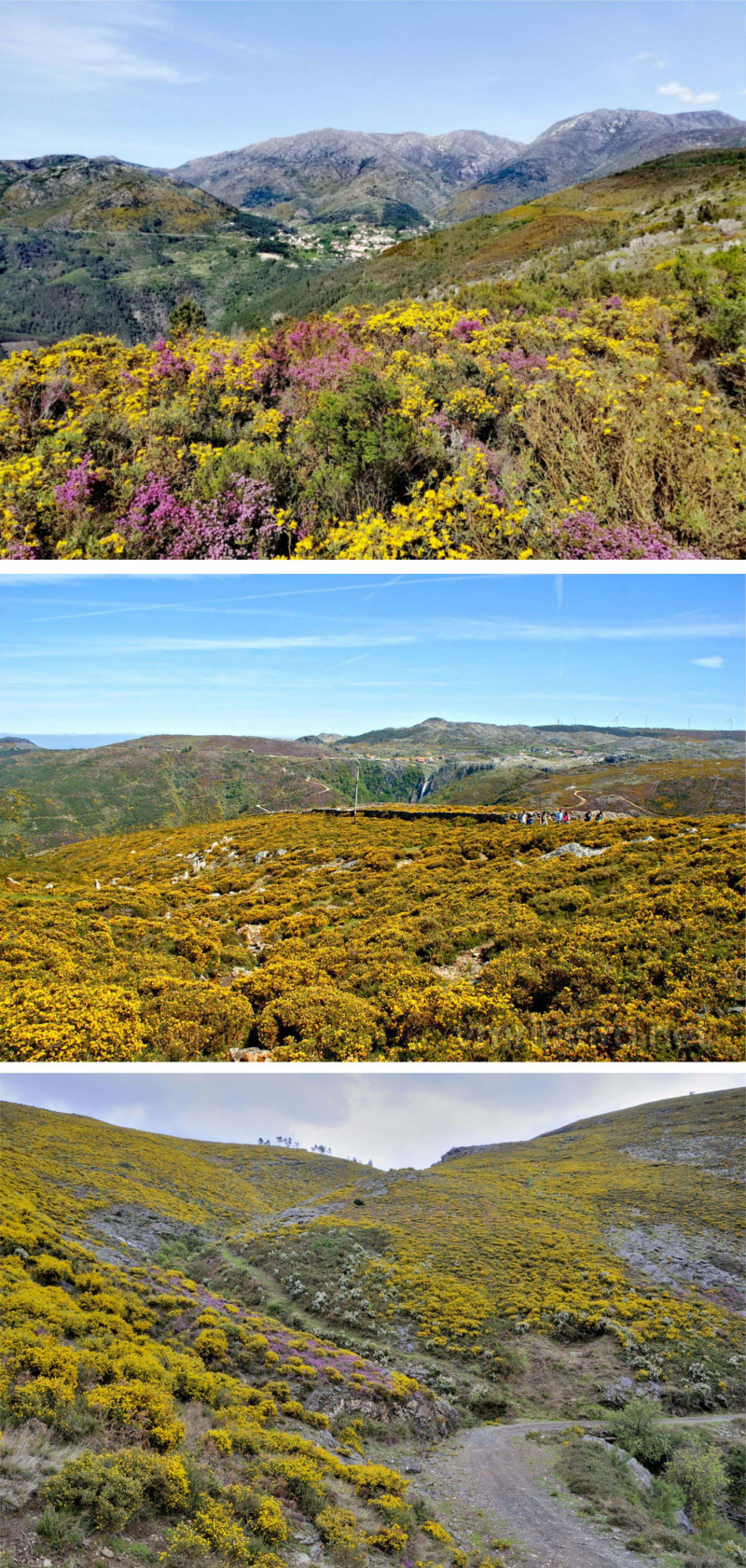
# 0045
Carqueja (Gorse)
Material, Item individual, Comum, Forrageado, Dias
Dados Sócio-culturias
Usos Históricos
Carqueja is a plant that spontaneously grows in mountains and fields, without having to be planted or cultivated. The plant after drying and in contact with fire is extremely combustible and has a high caloric power. In this way, at the end of the 19th century and the beginning of the 20th century, when electric ovens did not exist yet, the carqueja was used as a lighter for ovens in bakeries, homes and was still used in fireplaces to heat the bourgeois houses in the Porto city, in Portugal. Being a product of great abundance, that in a certain way it was tapped, its cost was very low and, therefore, its trade was wide. In the same period, carqueja was also used in cooking (a good example is carqueja rice), in addition to medicinal and therapeutic purposes, as it is still today. About Carquejeiras of Porto The Carquejeiras were ‘iron’ women, poor and fighters, who carried an important part of the history of Porto. However, there is a lot of “hidden” suffering behind this context. At the end of the 19th century, until the 1940s, in Gondomar, Melres and Sebolido, there were people who locally caught the carqueja, that grew on the hills. This plant was gathered and placed in rabelo boats that went down the Douro River to Porto, more precisely in Guindais. At dawn, the carquejeiras went by the river to discharge the boats. With the help of boatmen and rakes (utensil used in washing), these women placed the carqueja ranches on the floor in order to organize end orient them by shape and size so as to form the bales. A meticulous careful process to prevent branches from falling when being transported. The bales were tied and with the help of a rope, that passed through the carquejeiras´s forehead, they were carried on theirs back. The cargo weighed between 30 and 50 kilos and were twice as large as the figure of these fragile women. As the carqueja is sharp, the carquejeiras used the serapilheira (a kind of fabric) that protected their heads and backs. And so, they went up the Rampa da Corticeira, that connected the Guindais to the Fontainhas. This slope, with 22% inclination, represented the most arduous part of the route. Then, they walked in areas like Carvalhido, Paranhos, Boavista and Antas to distribute the carqueja to their customers. While the carqueja turned embers in some ovens, the carquejeiras returned to the river to catch more carqueja and repeated this journey several times a day. At the end of the journey, they receive very little money. They arrived tired in their homes and still had to play their role as a "woman". Theirs husbands often mistreated them. It was a time with alcoholism problems, where there were no day care canters or social support. The children themselves were victims of the mothers' situation, because of the fact that the fathers were rarely present. These women worked hard and walked miles on foot, often hungry, pregnant, with the children in their arms or with them clinging to their skirts. Over the years, faced with inhuman work, the carquejeiras often got sick, developed health problems or anatomical deformities. They were figures that impressed some people because of their suffering and sad looks. They were also poor women without literacy and marginalized by society. At a certain point, they were forbidden from moving around the city. The carquejeiras walked barefoot or with slippers and always looking down. Lourdes dos Anjos, a poet, born in Porto city, says: “Eu não se se algum dia elas olharam para o céu. Eu penso que elas só conheciam mesmo as pedras da rua.” “Das Fontainhas até o Largo 24 de Agosto, não sei como elas traziam uma carga tão ‘bestial’, porque aquilo não era para gente, era mesmo para bestas.” “Aquelas mulheres que faziam das pedras desta rua o seu rosário de todos os dias, eu não sei se elas sabiam rezar…, mas também não precisavam, porque a vida que elas carregavam, era um rio de lágrimas, era um rosto de sofrimento, e era sempre um querer amar mais aqueles filhos que tinham parido… As carquejeiras eram gente muito pobre.” “I don't know if they ever looked at the sky. I think they only knew the stones of the street.” "From Fontainhas to The Largo 24 de Agosto, I don't know how they brought such a 'bestial' cargo, because that was not for people, it was for beasts." “Those women who made the stones of this street their daily rosary, I don't know if they knew how to pray…, but they also didn't need to, because the life they carried on was a river of tears, it was a face of suffering, and it was always a desire to love more those children who had given birth… The carquejeiras were very poor people.” António Santos, representative of the Liga Portuguesa da Profilaxia Social says: “Havia uma saga social que era o trabalho físico desumano, quase escravo… e de mulheres. E não raro, de jovens, adolescentes, para não dizer crianças. Homens foram poucos… Mas foi esta severidade de ocupação que alertou os diretores da liga de lá então” “There was a social saga that was inhuman, almost slave labor… and of women. Not rarely, it was of young people, teenagers, not to say children. Men were few ... But this severity of occupation, that alerted the league directors´ at that time.”
Impacto Histórico
During the 19th century, the city of Porto was marked by great political leadership. The Liberal Revolution of 1820 developed in Porto, where liberalism triumphed against absolutism. In Porto, it was elected the first republican deputy for cuts and in 1891 an attempt was made to implant the republican regime. In 1927, still in Porto, the revolution took place with the military dictatorship. However, from the 1920s onwards, the city's political importance began to decline. With the industrial development, Porto started to be recognized as the city of work, but despite this context, it was not recognized in terms of tourism. For this reason, it was important to convey the image of a dynamic, modern and industrial city. Therefore, there was no prominent space for manual labor. Just like as child labor, the work of carquejeiras and the poor working conditions, as some men and many women, were hidden. The same society that preached for progress was turning a blind eye to what was going on with these struggling and suffering women. In a country that aimed at the image of being modern, it was essential to hide serious social problems. However, like other professions, carquejeiras contributed to the self-sustainability of Porto, since the city's growth was not based only on politicians, intellectuals and managers. The work of these hardworking women was of great importance for commercial development, especially for bakeries that needed their ovens working. Unfortunately, over time, the carquejeiras that played an important role in the progress of the city of Porto, were forgotten.
Uso Histórico · Imagem / Vídeo / Áudio (.jpg, .png, .mp4, .mp3 até 30MB)

Usos Presentes
Nowadays, the Carqueja (gorse) can be used both for cooking and for medicinal purposes. In Portuguese cooking, only the green part of the plant is used, curious stems flanked by a ribbon-shaped structure and which always seem dry and hard. The plant gives a wild flavor to dishes such as the meek rabbit to the hunter, partridges, pheasants and poultry quails and the famous Carqueja Rice. Yellow and very bitter flowers (image 08) are used in folk medicine. Its benefits are widely known in Portugal and the use goes far beyond the consumption of teas and infusions, being very effective and revealing a great set of qualities: • Helps in the functioning of the liver and more properly in the treatment of liver congestion. • It helps in the treatment of diabetes since the intake of gorse decreases the absorption of sugars present in food. • Helps in weight loss and eliminate liquid since it has a diuretic effect. The plant can also increase body temperature and speed up metabolism. • Helps to reduce and control cholesterol. • It has anti-inflammatory and antioxidant effect. Blood circulation also improves and fights the presence of free radicals (responsible for the aging of our body). In addition to its culinary and medicinal use (more widely applied), even if in a smaller proportion, this plant is still used as fodder for cattle and in some cases, for bread baking ovens since it burns very quickly and produces a lot of energy (heat). This is a way of maintaining the old tradition of using carqueja in Porto city.
Impacto Presente
The carqueja, in addition to being used today in cooking, as well as for medicinal and therapeutic purposes, is a plant that carries a great history. A history with a great importance in the Porto city development, and also, with a lot of suffering. The Associação de Homenagem às Carquejeiras hat with the main objective to erect a sculptural monument in honor of these women. They were concerned with making a statue of naturalistic curries so that everyone could observe, think and meditate of everything that was behind the history of carqueja during that time. Maria Arminda Santos, president of the association says: “Esta escultura lembrará as memórias do passado e levará o conhecimento para o futuro.” “This sculpture will remember the memories of the past and take information to the future.”
Uso Presente · Imagem / Vídeo / Áudio (.jpg, .png, .mp4, .mp3 até 30MB)

Outros Factos Fascinantes
In the 1960s, Maria Arminda Santos, who was still a sculpture student at the Escola de Belas Artes of the Porto city, used to go to Fontainhas to draw urban contracts. At that time, her work was sometimes interrupted by some old carquejeiras who lived there. They used to ask her: “Oh menina! O que estas a fazer? - “Hey girl! What are you doing? What's it for?" During the interruptions, Arminda came across reports made by these women, who never left her mind. Because of her busy professional life, Arminda kept as a goal to one day explore the theme of the carquejeiras. In 2015, when she was already retired, she decided to put her project into practice and together with a group of citizens, she created the Associação de Homenagem às Carquejeiras, with the unique purpose to erect a statue in memory of these women who have long been forgotten, abandoned, discredited and humanly minimized. Maria Arminda Santos (president of the association), reports: “Enquanto aqui nesta rampa (Calçada das Carquejeiras), onde ficam pedaços de pessoas, de almas, de gente que se amava, no outro lado, a cidade vivia muito distraída com as novidades, poderíamos dizer a vida ‘a la française’… distraída com a evolução, as óperas, os cabarets, as fitas, os vestidos bonitos, ninguém ligava para esta comunidade tão sofrida. Por isto o nosso projeto chama-se: Homenagem às carquejeiras do Porto – Um drama silencioso e silenciado.” “While here, on this ramp (Calçada das Carquejeiras), where it was left pieces of people, of souls, of people that loved each other, in the other side, the city was very distracted by the news, we could say life 'a la française' ... distracted with the evolution, the operas, the cabarets, the ribbons, the beautiful dresses, nobody cared about this community so suffered. For this reason, our project is called: Homage to the carquejeiras of Porto - A silent and silenced drama.” Arminda explains that it is silent because they suffered alone, with health problems, family, socioeconomic and many other things. A life really suffered. Despite a lot of awareness that happed through the Portuguesa da Profilaxia Social (partner even in the project) that worked for 40 years to prevent this drama from happening, many did not watch over these women. Therefore, for a long time, it was a silenced drama. Arminda tells that when she decided to put her project into practice, she immediately had the help of 3 important people: Helder Pacheco (professor of social and cultural history in Porto), Germando Silva (journalist) and Joel Cleto (archaeologist). She also had the support of some authorities such as the Junta de Freguesia do Bonfim, which until today, including the president, supports the cause, in addition to the Fundação Manuel António de Mota. Besides to seeking support, Arminda also contacted one of Portugal's most renowned sculptors, José Lamas. Obviously, she could develop the sculpture, however, she preferred to follow the project from another point of view and participate in all of steps, which would not happen, if she were fully involved in the development of the monument. José Lamas presented the proposal for the sculpture through a model, which after being approved by the association, was presented to more than 25 institutions that welcomed them. From this point, they were able to effectively start the project. It is because they needed investment since the sculpture would be made in bronze and would have a high cost. There were many advances and setbacks. Many ‘no’: “They said they couldn’t help us because it was not foreseen in the activities of the company or the institution. That the project deserved all the affection, all the acceptance - very beautiful words about our altruism, about how we remembered to take memories, in such distant strata of history, worthy of appreciation.” Maximina Girão, Rui Claro and Luís Pacheco, together with Arminda, were the faces behind the persistence. They, in addition to the institutions, also managed to sensitize a large group of citizens who supported them and gave a lot of strength for the project to move forward. It was 5 years of hard work, with the disclosure of the project through events, exhibitions and social networks. It was tough, but at the end, it worked. During this time, they obtained support and pooled resources to erect the monument. It was possible because it is a project that deals with the people. From a people that made history and that needed to be recognized. Arminda reports: We started from scratch. We had absolutely no money, but we had the dream. During these five years, we gathered the money and now, we have the dream come true…”- “We started from scratch. We had absolutely no money. We had the dream, and, during these five years, we gathered the money and we have the dream come true…” On March 1, 2020, the statue named Maria, like so many women, was erected at the top of the Rampa da Corticeira, today called Calçada das Carquejeiras. With the inauguration of the monument, Arminda says: “A associação cumpriu o seu projeto e morre, ficando só simbolicamente uma atividade a que nós damos muita importância, que é a descida da rampa das carquejeiras, depositando flores por aquela granítica e fria calçada onde pedaços de almas ficaram por lá dispersas – gente que, como um cidadão, amava, vivia, tinha os seus filhos, a sua família. E é em prol dessa gente que valeu a pena dar continuidade e finalizar o nosso projeto.” “Foi com elas que eu comecei a fazer os primeiros desenhos, e é com elas que acabo e fecho este nosso projeto, que foi bonito, foi ótimo, foi sentido, foi sofrido – mas que vai permitir homenagear essas mulheres.” “The association fulfilled its project and dies, only symbolically remaining an activity to which, we attach great importance, which is the descent of the carquejeiras ramp, placing flowers on that granite and cold sidewalk where pieces of souls were scattered there - people who, as a citizen, he loved, lived, had his children, his family. And it is for these people that it was worthwhile to continue and finalize our project.” “It was with them that I started making the first drawings, and it is with them that I finish and close this project of ours, which was beautiful, it was great, it was felt, it was suffered - but that will allow us to honor these women.”
Dados Técnicos
Dados Geográficos Bio-temporais
Local de Origem · Imagem / Vídeo / Áudio (.jpg, .png, .mp4, .mp3 até 30MB)

Tempo de residência (Quando tempo é que a matéria/material/artefacto se mantém num estado inalterado numa localização/contexto/sistema antes da sua degradação?)
Dias
Como é que o item afeta o ambiente no qual existe?
Nutre-o
Dados Ontológicos-cosmológicos
fascinating history
Como é que gostaria de estar com este artefacto/material/ser vivo/matéria?
I would like to keep close to the Associação de Homemagem às carquejeiras and to know more about the history behind this interesting context behind this plant.
Como é que transformar este artefacto/material/ser vivo/matéria? o/a transforma a si?
As a sad before, I'm really fascinated with this plant.
O que é que o ser humano pode devolver a este artefacto/material/ser vivo/matéria?
I believe that to have this project about the carqueja and carquejeiras in Porto Bienal will be a great way to lead information to people, in addition to honour this extraordinary women.